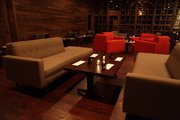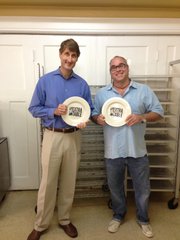Robert St. John Photo by Melanie Boyd.
To say Robert St. John is modest about what led to his success is to put it lightly. The Hattiesburg, Miss., native insists he "sort of fell backward" into the overwhelming success he's enjoyed as a chef, restaurateur, author, businessman and philanthropist.
But despite stumbling blocks and unexpected twists, today St. John is one of the state's most beloved chefs. At the end of the day, St. John says his greatest role is being a dad to daughter Holleman, 16, and son Harrison, 12.
I sat down with St. John in his newest establishment, the upscale cocktails-and-small-plates bar Branch in Hattiesburg—part of a grand renovation and expansion of his restaurant complex—to talk about flunking college, best-selling cookbooks, battling food insecurity and everything in between.
So, tell me about growing up here in Hattiesburg. Did you always want to be a chef?
I grew up about four blocks that way. My dad died when I was 6. My mom was a schoolteacher, never remarried, raised my brother and me. She was a single mom kind of before single moms were cool. Still to this day, she's 80 years old and still teaching school.
So, a great childhood. I started working when I was about in the sixth grade, mowing yards and whatnot. We didn't have a lot of money, so if I was going to have something to spend, I had to work.
When I was 15, I became a (radio) DJ. I worked 40 hours a week all through school and went off to Mississippi State in 1979 and thought I'd major in communications.
After a couple years, that wasn't working out for me, and Mississippi State decided they no longer needed my services in Starkville. So I left with whatever my grade point average was—there was nothing on the left side of the decimal point, whatever it was. It was bad.
But it's really, in retrospect, probably the best thing that ever happened to me. Because after flunking out of school, I came back to Hattiesburg and started working in a restaurant.
How did that go?
Two ladies wanted to open a delicatessen. They'd never been in the restaurant business before, which is evident because they hired me, as a 19-year-old college dropout, as the manager of the place. I had been a bartender at Starkville at a place where they would let you drink free beer while you worked—I thought, "This makes a lot of sense, I can make money and drink free beer, and this is where I'm going to be anyway."
That was all the experience I had in my hospitality-management career (before working at this restaurant). And I just fell in love with the restaurant business.
So I went back to USM after a couple years and got through pretty quickly—18 to 20 hours, summer school, the whole deal (while working 40 hours a week). I was pretty single-minded. I wanted to open a restaurant.
In '87—I was 26—I opened Purple Parrot Cafe. /Were you cooking as well?
The extent of my cooking knowledge when we opened was that I had asked for and received an Easy Bake Oven when I was 6 years old for Christmas. That was it. We had to fire our chef opening night, so night number two, I got kind of thrown to the wolves and in the fire.
There have been a lot of those things in my life where it looked like a bad situation or catastrophe or the worst thing that could possibly happen.
In retrospect over some years, you look back and go: You know what? It's better it happened that way. It's better we got rid of him opening night because I might never have gotten in the kitchen.
Since that second day in the kitchen, how would you describe your growth as a chef?
You know, I've been voted Best Chef in Mississippi (by Mississippi Magazine) three times, and I promise you I'm not even the best chef in my own restaurant. There are five or six guys that can run circles around me in this place.
To be honest, I'm a pretty mediocre chef who has just gotten really lucky. I'm a much better eater than I am a chef.
How did you get into writing cookbooks?
Here's the deal: I'm a mediocre chef, an average writer and a good restaurateur. But I hope to be a great dad, so there's that.
But the cookbook thing happened because I started writing a column. It was pretty bad at first but then I started developing a passion for that, too, and I really liked that. A lady who eats here all the time was always trying to get me to do stuff. She started saying, "Robert, you need to do a cookbook." And she kept on, and kept on and then one day she was sitting out at table 3 at the Purple Parrot with a gentleman, and she said, "Robert, come sit down. This is so-and-so with a publishing company. Tell him about your cookbook."
Well, I hadn't even thought about it other than telling her I didn't want to do it. So, trying to think quickly on my feet, I said: "Well, if I was going to do a cookbook, I'd have recipes I've developed here at the restaurant. I would have stories about the South and food of the South. And then I would have watercolors by Wyatt Waters."
And without missing a beat, this guy says, "Well, if you get Wyatt Waters, you've got a deal."
The problem was, I didn't know Wyatt Waters at the time. ... So very unlike me, the next day I drove up to his gallery in Clinton, walked in and introduced myself. And about six hours later, I think I left. We just hit it off instantly, and within a month or two we were best friends. We did that book, which was called "A Southern Palate," and it was just this crazy thing.
How so?
Well (we ended up self-publishing). So this book came out maybe the end of October, and we sold out before Thanksgiving. It was just nuts. There will never be anything like that, and there hasn't been. ... It was all we could do to keep up. We were out in three weeks, and we almost sold out the second printing without even having the book. We were selling these little packages that had a promise for a book.
"An Italian Palate" is your ninth book as author and third collaboration with Wyatt Waters. How did it come together?
Again, by accident. I don't plan a lot; things just sort of happen. My friend David Trigiani in Jackson is a dual-citizen Italian, and he's a great Italian cook, so I would go up once a week and spend time with him in his house learning his mama's gravy and this sort of thing. Wyatt would come over a lot, and the three of us would have lunch. I had been planning a trip with my wife and two kids to Europe—we did 17 countries on two continents in six months—and as I planned this trip, I brought it up to Wyatt and said, "Why don't you come over—maybe our next book is done in Italy?" And it was like (snaps fingers): Boom, he was in.
(My family) had been over in Europe; we had hit about 10 countries by the first of October, when we picked Wyatt up. He had been in Venice for 10 days, and then he spent the next 10 weeks with us. We covered from the southernmost tip of Sicily to the Alps.
In the morning we'd get in the car and go into Florence or wherever, and ... he would go paint, and I would go eat. He had the tougher job, really. Sometimes I would be back in the kitchen with the chefs in their restaurants. We made a lot of friends over there, and I would go to their homes and cook.
The thing about it was, Wyatt had never been in a situation where all he had to do was paint. ... In 10 weeks, he finished 128 watercolors. He was a machine over there. It's some of the most beautiful work he's ever done.
Tell me about your nonprofit, Extra Table.
We've always been plugged in to the community here. We just want to help everybody we can help, so we get a lot of calls.
I got a call one day from the Edward Street Fellowship Center, which is a mission pantry here in town that fed about 800 families a month (at the time—now it feeds 1,200). They had completely run out of food, and they were freaking out, and they said, "Is there anything you can do to help us?" So I said, "Sure."
I figured the easiest, best, quickest way to help them would be to call my Sysco rep, just put together an order and have them drop-ship the truck to the agency.
And I started thinking, bet people would give more often and more freely if there was an easier way to do it. So I went ahead and grouped all those foods I had found into three packages—$250, $500 and $750. And I went to Sysco and said, "I've got this idea: What if every restaurant, business and home had an extra table where they could feed those in need?"
(Sysco agreed to) deliver the food and give us rock-bottom wholesale prices.
Then I started traveling the state going to soup kitchens and mission pantries, and to be honest with you, I hate to admit it, but I was even a little skeptical that we had a hunger problem. This is the United States of America. And I learned quickly how wrong I was. It was a cold slap in the face of reality. I ran into single moms, like I had, who were holding down two jobs and trying to make ends meet. Seniors—a lot of what you see at soup kitchens are seniors living on fixed incomes trying to figure out, "Can I pay the light bill, or can I go to the grocery store?" And the worst of all are kids. There are over 200,000 kids in Mississippi who eat a school breakfast, a school lunch and then don't eat again until the next day.
So what we have is over 638,000—over 300,000 seniors and over 200,000 kids—who are what the government calls "food insecure." Which really means they don't know where their next meal is coming from. Now you think of kids who are having school breakfast, school lunch and don't eat again until the next day, and then you think about summer. What happens there?
What is different about the food you provide?
A lot of mission pantries are funded by food drives by churches and businesses, but unfortunately, a lot of the time what happens is people use it as an opportunity to clean out their pantry. So it's old food, it's dented cans, and you'll go through the shelves and see something like cherry-pie filling. People don't need that to live. These people are looking for food to live.
In doing the research on these places, what I learned is there is high instances of diabetes and obesity. And that's part of the problem that I couldn't make a connection. How could we be the most food insecure state in the country—and we are—and the most obese? But what I learned is those two always go hand-in-hand. Because if you don't have enough money to buy proper food, you go to a convenience store and buy junk food and fruity drinks, and that's what you live on. That's where obesity and diabetes comes from.
So all Extra Table food is shelf-stable, low-fat proteins, low-sugar fruits, low-sodium vegetables, healthy grains. It's a great system. Plus, if you wanted to give to Stewpot, say, and you went to the grocery store and bought a shopping cart full of food—well, because we are using our shopping power and buying wholesale, we can buy two shopping carts for the same amount of money.
Here's an example: Edward Street Fellowship Center here in Hattiesburg that was running out of food a few years ago, this year, because of Extra Table, from January through June didn't even have to buy food. The beauty of that is they have other programs. So the money they have budgeted for food they can put to afterschool programs with at-risk youth, Boy Scouts, Girl Scouts, a community garden. ... Stewpot, you know, has had to drop a couple of their services. Now thanks to Jeff (Good) and Dan (Blumenthal, both of Mangia Bene)—we're about to have a big launch up there for Jackson—we hope to get to the point where we're shipping enough food to Stewpot that they can take the money and put it back into some of those services that they are missing.
It seems like Extra Table is growing quickly. What is next?
I don't want to talk about moving out of Mississippi, yet, but our goal right now is to be supplying the Coast by the end of the year and then in the first half of 2014 we'll be in north Mississippi. We've got a couple grants out there that we are working on and hope to be supplying food to every county in Mississippi. That's our goal next year, to be shipping food to all 82 counties in Mississippi.
Visit robertstjohn.com and extratable.org for more information on the chef and his nonprofit. Robert St. John owns the Purple Parrot Cafe, Crescent City Grill, the Mahogany Bar and Branch.
Robert's Bibliography
"A Southern Palate," with Wyatt Waters (Purple Parrot Co. Inc., 2002)
"Nobody's Poet: the Food Columns of Robert St. John," with Marshall Ramsey (Different Drummer Press, 2004)
"Deep South Staples: or How to Survive in a Southern Kitchen Without a Can of Cream of Mushroom Soup" (Hyperion, 2006, $19.95)
"Deep South Parties: How to Survive the Southern Cocktail Hour Without a Box of French Onion Soup Mix, A Block of Processed Cheese, or A Cocktail Weenie" (Hyperion, 2006, $19.95)
"Southern Seasons," with Wyatt Waters (Purple Parrot Co. Inc., 2007)
"New South Grilling: Fresh and Exciting Recipes from the Third Coast" (Hyperion, 2008, $29.95)
"Dispatches from My South: Reflections and Recipes from a Southern Food Scribe" (Purple Parrot Co. Inc., 2009)
"An Italian Palate," with Wyatt Waters (Purple Parrot Co. Inc., 2013)





